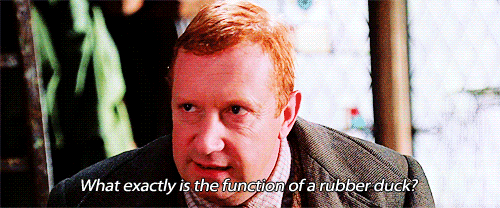In honor of Harry’s birthday and the release of the latest in the Harry Potter franchise by J. K. Rowling (yes, I know it’s a script, but hey, I don’t ruin your dreams by pointing out they’re only half-true, do I?), I’m giving you direct access to all of the knowledge I’ve gained since working with inbound marketing for B2B clients.

It's not every day yer young man turns 11, now is it? - Rubeus Hagrid
Sometimes I feel like this is what our clients think we’re telling them when we introduce inbound:
 Me: Now, all you have to do...is walk straight at the wall between platforms 9 and 10. Best to do it at a bit of a run if you're nervous.
Me: Now, all you have to do...is walk straight at the wall between platforms 9 and 10. Best to do it at a bit of a run if you're nervous.
Client: Sounds legit.
And then they throw something about SEO at me, and I feel like Harry does in this scene:

Not to worry, dear. We’ve all felt the confusion that comes with learning inbound as a brand new methodology, the ‘aha’ moment when we question how we’ve ever done it any other way, and the confirming excitement when we see the results after the first few months of applying inbound to our marketing and sales process. In fact, here are the biggest things I learned - and what you can expect to learn if you implement inbound marketing for your B2B company.
1. Terminology
Where was Oliver Wood when I was learning all of the terminology of inbound marketing?
The Buyer’s Journey: Awareness, Consideration, Decision.
The Sales Funnel: Visitor, Lead, MQL, SQL, Opportunity, Customer.
The Inbound Methodology: Attract, Convert, Nurture, Close, Delight.
There are many terms used in the inbound community (and in marketing in general, to be fair) to describe an entirely logical way of thinking about how buyers make purchasing decisions, and how B2B organizations can arrange their sites, marketing materials, and sales process around them.

In the end, I don’t care how you say it (unlike Hermione) as long as you’re doing it, because it works.
2. SEO
SEO is a Muggle activity.
It’s slow, it takes dedication and work, and can’t be manipulated by a secret, magic formula. You’re able to pay an agency like ours to research, identify, and implement top keywords and key phrases on your site to help you rank higher in organic search results - over time. It's not an easy task.

It's not an overnight or even a one-month process. It takes months to take hold and work well. But with dedication and persistence, it can happen. Take a look at our case study for client Strong Blocks for an example of what happened over the first six months using an inbound content strategy.
3. Transparency
Unlike the wizarding world of which Harry is suddenly a part, there’s almost unlimited access to data and information about your marketing tactics in the inbound world.

This was quite different for me moving from outbound to inbound marketing. Outbound marketing is difficult to track on its best day, and impossible at its worse. Our clients spending on outbound tactics like radio, TV, billboards, or newspaper ads were amazed at the ability to track their marketing investment through inbound tactics. Better still, the amount they were spending per lead attributed to each was 61% less on average than outbound leads. (HubSpot)
4. Outbound is you-centric; Inbound is customer-centric.
The motivation behind the why is huge. Inbounders build websites, content, and sales conversations around what the potential client needs to know and wants to hear about. Outbound marketers build websites to showcase products and information they want potential clients to know about. The difference is subtle, but the results are huge. Education and knowledge-sharing gives you an in to continue communication with visitors who come to your site, converting them to leads. Does your product-centric site do that?

5. Marketing Spend vs. Investment
The most trackable form of outbound advertising that our clients engage in is typically web banner advertising - it’s targetable, trackable, and drives traffic to the site. But, is it truly giving you the right visitors?

Inbound eliminates the need to advertise via web banners - and a whole lot of other media. It attracts potential leads and clients to your site through quality, relevant content and converts them using calls-to-action and quality downloadable pieces.
6. Return on Investment
Unlike using outbound agencies, an inbound agency can prove their worth.
An outbound agency can show you where your money was spent. An ROI-focused inbound agency can show you what was produced on your site, and how many leads and sales that work generated, instantly proving the return on your investment in the strategy and work of the agency. Check out our ROI calculator here.
7. Content Creation

I frequently wish that I had a (freed) house elf to help write content. Everything produced and published on a website or in sales materials needs to be researched, educational, relevant, and above all, useful to prospects. It’s a lot of work! And it can be overwhelming sometimes. But at the end of the day, Harry and Ron have some great advice for marketing teams everywhere, myself included:

Do Something! - Harry
What? - Ron
Anything! - Harry
(Obviously, the anything should be useful - but just get. It. Done!)
8. Impact
It’s not an invisibility cloak.
You’ll begin to see the immediate impact of inbound marketing compared to outbound. The first proof will be the leads converted on your site. These are the visitors that you wouldn’t have known otherwise, and that’s incredibly useful for your marketing strategy and sales team. You’ll also be able to draw a direct line from budget, to content, to conversions, to closed customers.

You ought to be careful. People will think you’re...up to something. - Severus Snape
9. Knowledge & Learning
I love, love, love how much inbounders love to learn new things. Data drives us, knowledge keeps us going, and learning new things is a passion. It’s infectious! And we share it with our clients, implementing new and creative ways to meet their goals each month.
At times, I feel like having this conversation with my team:
 Team: I checked this out weeks ago for a bit of light reading.
Team: I checked this out weeks ago for a bit of light reading.
Me: This...is light?
But it’s so important and beneficial to employee engagement that we maintain a high level of learning.
9 ¾. Strategy

Yep, that’s what I feel like sometimes. A nerdy, detailed strategist can make all the difference to the success of your inbound marketing.
Of course, I’m kidding. In all honesty, you need an entire team behind the success of your inbound marketing. A strategist, a writer, a designer, and a coordinator to make sure it all gets done, at minimum. That’s where an inbound agency becomes a smart investment. The agency team is experienced, trained, knowledgeable, and working for you.

Implementing inbound marketing for your B2B company is exciting. It gets results that you’ve always wanted, in the measureable, accountable way your CEO has been begging for. If this sounds like a great fit for you, check out our upcoming Jülcast (15-minute live webinar) on how to calculate the ROI of Marketing on August 16th.



